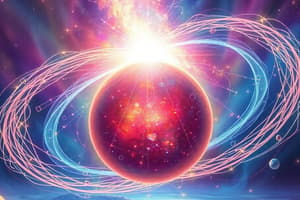Podcast
Questions and Answers
What is the formula for calculating flow rate?
What is the formula for calculating flow rate?
- FR = D + T
- FR = D × T
- FR = T / D
- FR = D / T (correct)
How does temperature affect the viscosity of a liquid?
How does temperature affect the viscosity of a liquid?
- Higher temperatures increase viscosity by causing more attraction between particles.
- Lower temperatures decrease viscosity by making particles move faster.
- Higher temperatures decrease viscosity by reducing friction between particles. (correct)
- Temperature has no effect on viscosity.
Which of the following examples demonstrates a liquid that requires low viscosity?
Which of the following examples demonstrates a liquid that requires low viscosity?
- Peanut butter stored in the fridge
- Paint for surface coverage
- Pancake batter for spreading
- Motor oil for lubrication (correct)
What does concentration refer to in terms of viscosity?
What does concentration refer to in terms of viscosity?
Which statement correctly describes the effect of the strength of attraction between particles on viscosity?
Which statement correctly describes the effect of the strength of attraction between particles on viscosity?
What is the main characteristic of a solid regarding particle arrangement?
What is the main characteristic of a solid regarding particle arrangement?
Which process describes the change of a liquid into a gas?
Which process describes the change of a liquid into a gas?
What happens to particles as they gain energy?
What happens to particles as they gain energy?
What term describes a liquid's resistance to flow?
What term describes a liquid's resistance to flow?
Which statement correctly reflects the nature of gases?
Which statement correctly reflects the nature of gases?
What describes the transition process from a solid to a gas?
What describes the transition process from a solid to a gas?
Which change of state occurs when heat is removed from a gas?
Which change of state occurs when heat is removed from a gas?
What type of force acts between particles in a substance?
What type of force acts between particles in a substance?
Flashcards
What is a fluid?
What is a fluid?
Anything that flows, such as liquids and gases.
What is viscosity?
What is viscosity?
A measure of how easily a liquid flows.
What is evaporation?
What is evaporation?
The change of state from a liquid to a gas.
What is condensation?
What is condensation?
Signup and view all the flashcards
What is melting?
What is melting?
Signup and view all the flashcards
What is solidification?
What is solidification?
Signup and view all the flashcards
What is sublimation?
What is sublimation?
Signup and view all the flashcards
What is deposition?
What is deposition?
Signup and view all the flashcards
Viscosity
Viscosity
Signup and view all the flashcards
Flow Rate
Flow Rate
Signup and view all the flashcards
Temperature and Viscosity
Temperature and Viscosity
Signup and view all the flashcards
Concentration and Viscosity
Concentration and Viscosity
Signup and view all the flashcards
Attractive Forces and Viscosity
Attractive Forces and Viscosity
Signup and view all the flashcards
Study Notes
States of Matter
-
Fluid: Anything that flows (liquid or gas). Examples include water, syrup, and compressed air.
-
Solids: Have a definite shape and volume. Particles are close together and vibrate in place.
-
Liquids: Have an indefinite shape but a definite volume. Particles are close together and flow freely.
-
Gases: Have an indefinite shape and volume. Particles are far apart and move randomly.
Changes of State
-
Evaporation: Liquid to gas.
-
Condensation: Gas to liquid.
-
Melting: Solid to liquid.
-
Solidification: Liquid to solid.
-
Sublimation: Solid to gas.
-
Deposition: Gas to solid.
Particle Theory of Matter
-
Matter is made of tiny particles.
-
Particles in the same substance are identical.
-
Particles are always moving.
-
Particles have spaces between them.
-
Particles are attracted to each other. Attraction strength depends on particle type.
-
Increased energy (heat) increases particle speed.
-
Reducing energy (cooling) decreases particle speed.
Viscosity
-
Viscosity is a liquid's resistance to flow (thickness/thinness).
-
Higher friction between particles = higher viscosity.
-
Flow rate = distance / time.
Factors Affecting Viscosity
-
Temperature: Higher temperatures reduce viscosity, as particles move faster and farther apart.
-
Concentration: Higher concentration means more particles in a given volume, potentially increasing viscosity.
-
Attractive Forces: Stronger attractive forces between particles generally increase viscosity.
Studying That Suits You
Use AI to generate personalized quizzes and flashcards to suit your learning preferences.




